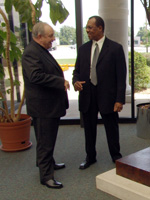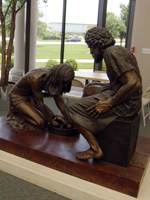 |
A unifying symbol at the seminary is a bronze sculpture (right) by Max Greiner Jr. of Jesus washing Peter's feet. Located in the seminary's Great Hall, it is a visual representation of a deep commitment to servant leadership that is part of the board's self-understanding. Board members (like the Rev. Alton Garrison, pictured to the left with Dr. Winston Larry) frequently make reference to the sculpture during deliberations, and it is the most often photographed symbol for seminary guests. |
 |
At most theological schools, the board visits the campus two or three times per year. Those few hectic days are typically filled with meetings at which senior staff deliver reports and answer questions.
But boards that are working at maximum capacity receive information in a variety of ways — sometimes through the president's cabinet members, but not always. They hear regularly from the president's office, but they also connect with one another through committee meetings and at social events. Most board members see their work as an act of service to God and to the church. Some even see the president as a spiritual leader. Board members typically want to feel both connected and nourished.
In Trust asked Byron D. Klaus to explain how his board stays connected and inspired. Klaus is president and professor of intercultural leadership studies at Assemblies of God Theological Seminary in Springfield, Missouri.
|
On campus
The board of directors of Assemblies of God Theological Seminary includes members from across the United States. Since time at our board meetings is tightly planned, we try to ensure that they gain a good understanding of the breadth of seminary life.
Outside of the board room, we employ a number of strategies to ensure that board members get a good feel for the seminary.
- Academic lectures. At least once a year, we schedule one of our academic lecture series during a board meeting. For example, last year, Dr. Mark Hausfeld from our global missions faculty lectured on Islam in America.
- Chapel. New board members are asked to speak during chapel from their unique vantage points. Lay members who work in the business world have spoken on "what I expect from my pastor." Board pastors have offered personal reflections on how they have navigated challenges in their ministry, revealing a personal side of their service to Christ and the church.
- Interaction with students. Students regularly take part in presentations to the board. Our annual student chili cook-off has even been judged by the board — a good way both to feed the body and to encourage student-board communication.
- Teach. Many of our board members are pastors who are alumni of the seminary. Board members regularly come early or stay late after board meetings so they can lead a seminar or give a lecture.
- Meet employees. On a rotating basis, employees are invited to attend meals with the board. We consider this an essential facet of board education, as the board gets to know all the staff members who make the seminary work.
- Global updates. Assemblies of God Theological Seminary has a strong commitment to world missions, and an annually appointed endowed chair of world missions brings some of our tradition's finest missiologists and international leaders to campus. To offer the board "insider" briefings, which they appreciate greatly, we regularly invite these missions leaders, as well as missiologists on our own faculty, to address the board while the board is on campus.
- Board dinner. Each year, my wife and I host a dinner for the entire board at our home. Each dinner features a presentation that focuses on the personal side of one of our team members — like our business manager who has run five marathons or our academic dean who migrated from China to the United States. And my wife's desserts are so popular that board members actually take dessert first to make sure they get their favorite.
|
|
Between meetings
The board of directors of Assemblies of God Theological Seminary meets twice a year — in February and October. It is always a challenge to educate busy people, so continual communication of several varieties is necessary to give the board the full picture of the seminary.
The board is divided into an executive committee and four subcommittees, including academic affairs, business, resource development, and student life (which comprises spiritual formation and enrollment services). Each subcommittee is chaired by a board member and is staffed by an administrator. The administrator serving each subcommittee communicates regularly with the subcommittee members through phone calls and electronic communications, alerting them to current issues.
All necessary documents are sent two weeks before each board meeting. Board members respond to regular electronic communication and timely mailings by participating fully and sharing their expertise. We have found that board members are ready to take ownership of the seminary's most pressing issues.experience for me."
|